The evolution of Razer mice on the example of DeathAdder and Naga
Hello Giktayms! It just so happened that Razer products were in the top interests of our online store during 2014. We were pleasantly surprised to see Razer products in the top interests of M.Video online buyers in 2014, so we decided to introduce you to all the interesting models updated by Razer last and this year.
Razer was one of the first to produce gaming accessories and peripherals, sharpened by an excellent user experience in games. Of course, what works great in the most demanding conditions for accuracy and speed of operation will perfectly cope with other tasks. So today we have two mice who are of special interest from the audience of players - Razer DeathAdder and

Razer Naga in the 2014 version.
Author's note:
In the Razer product line, mice occupy a separate category. Firstly, with the production of gaming mice Razer began their ascent to Olympus gaming peripherals. Secondly, it was high-quality mice that made the company her name and nurtured an army of fans around the world. DeathAdder is a classic ergonomic mouse for right-handed people (there is a version for left-handed people), not burdened with anything superfluous, moreover, in the Chroma version (with multi-color illumination), and the third generation of Naga mice. The third one is very formal, since the first two differed, rather, in the form of the MMO block of keys, but were technically identical.
The mouse is a typical representative of Razer products throughout. My first “personal” and “favorite” mouse for Razer was a wireless Mamba, and DeathAdder at that time was a complete copy of Mamba, devoid of wireless features and associated mini-buttons. DeathAdder survived several re-releases, some of them were announced officially (hardware was replaced in the mouse), some were an easy facelift: on the Internet, I found a photo with three horsemen of the apocalypse, who would say where is which mouse, but not Google? :)
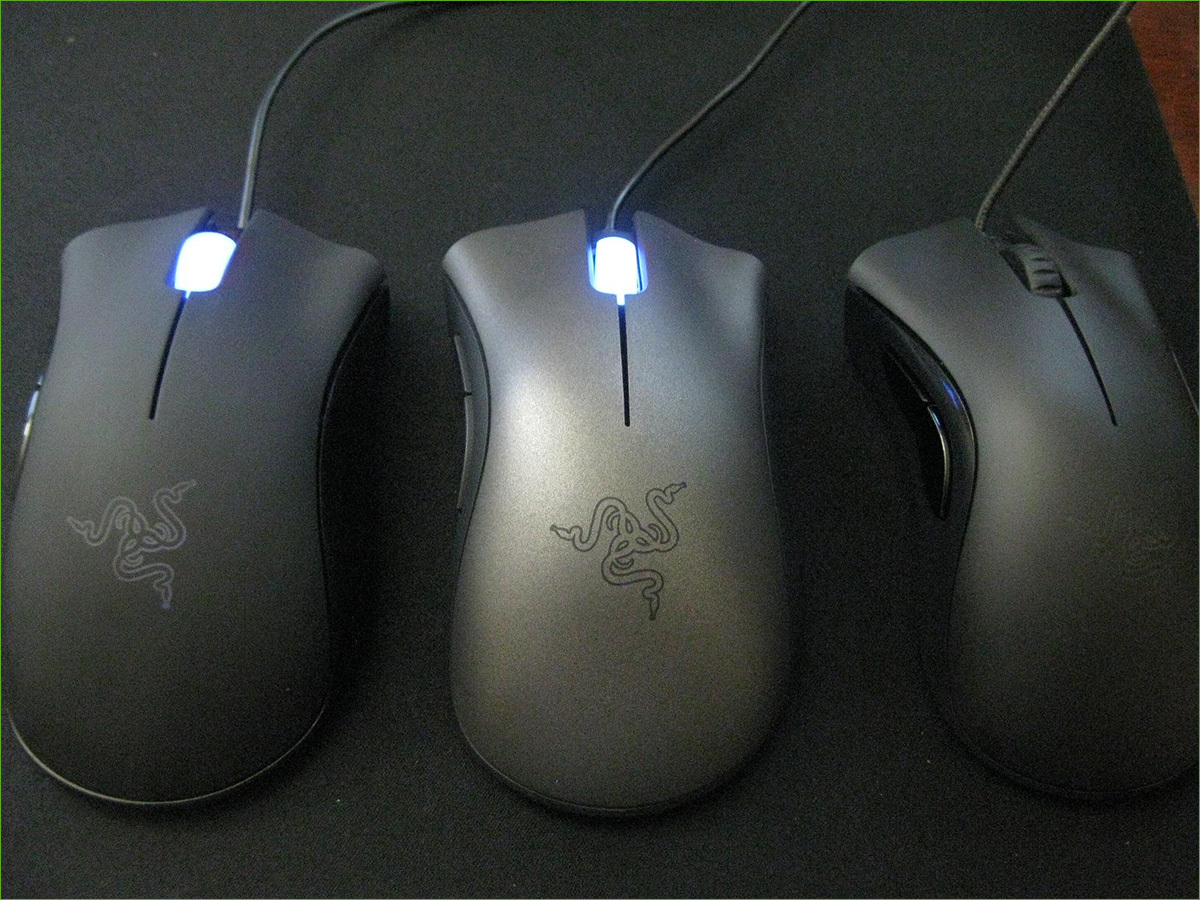
The main “upgrade” of DeathAdder was performed twice, once - inside the line of mice with a third-generation sensor, the second time - with a transfer to a 3.5G sensor. Now the mouse has been transferred to a new fourth-generation dual-sensor software and hardware platform, and even if it looks almost the same, the improvements are noticeable from the very first minutes of use.
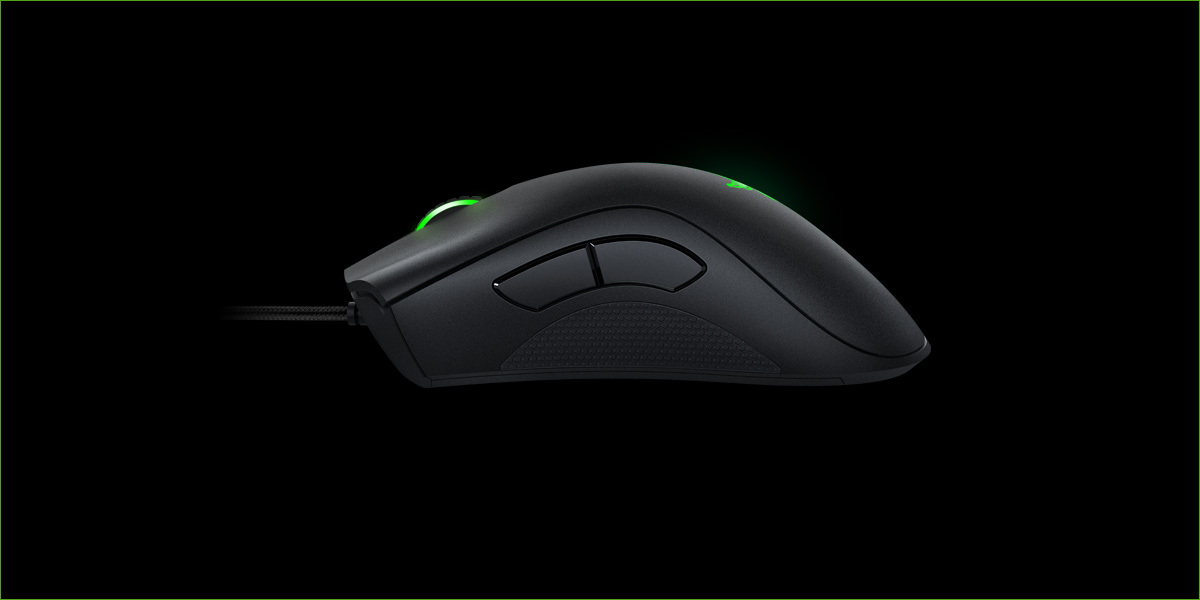
The shape of the new DeathAdder has not changed much: the "hump" is slightly less pronounced, a drop of another bend of the working surface (buttons), in general, a thousand little things that a simple average person simply won't notice. The difference is so subtle that I would rather distinguish both mice in the nature of the cursor movement than in shape.
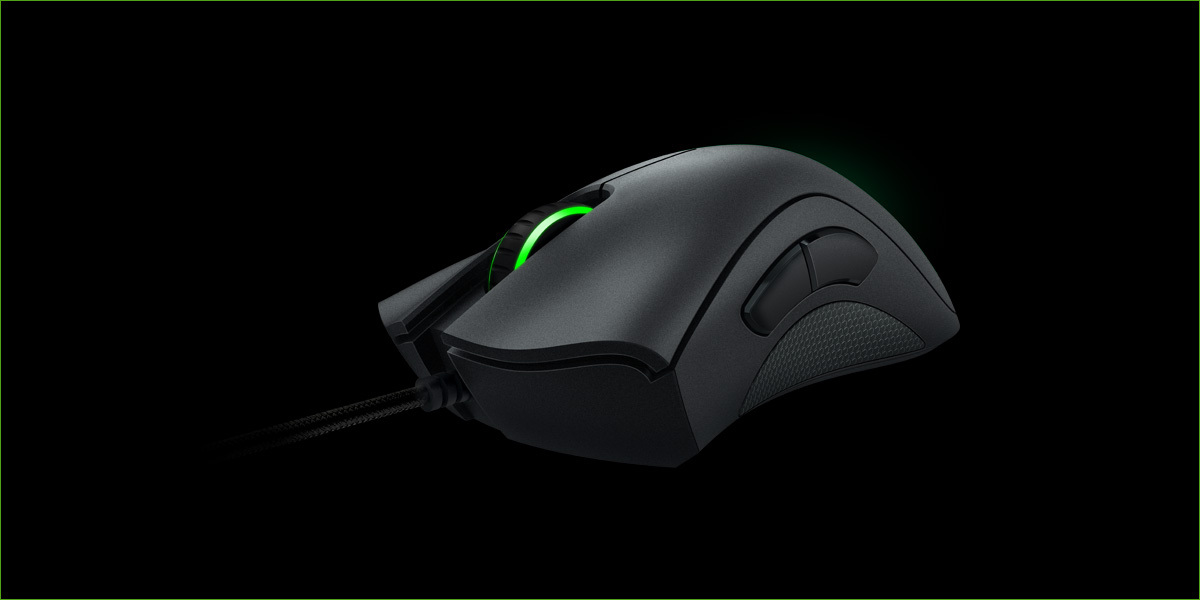
The key difference is other body materials. Models with a release date of 2008-2013 were characterized by a somewhat “different” design approach: some were made of high-quality semi-matte plastic, and some were made of soft-touch with glossy inserts. The gloss collected prints, and the soft-touch easily scratched with rings / jewelry / something in a backpack and began to treacherously peel off. If on desktop products this is not very noticeable and not critical, then those who wear their accessories with a laptop after a while either had to put up with a peeling coating, or disassemble the mouse and clean / paint the surface.
In 2014-2015, the company solved this problem radically. Now the main work surface and sidewalls are lost in gloss and chic in the photographs, but are made of high-quality, very “dry” and “hard” to the touch matte plastic. Tactilely very similar to carbon fiber. The material of rubber inserts has also changed, which should provide a reliable grip on the mouse: instead of soft and smooth elastic, corrugated / textured elements from harder compounds are now used. In the hand, the mouse began to lie somewhat differently - it may not look as expensive as past products, but it certainly has become better both in terms of user experience and banal practicality. Well, one of the most important improvements is the wire braid. It has become much stronger and thus more flexible (probably b used forfewer thinner threads). Let us hope that the wires cease to “double”, and the braid - fray and unwind, as was the case with some old products. Unfortunately, antifriction paws made of the same material as before were left on the mouse: on the first day they were covered with scratches and gathered a thin layer of worn material around the edges, so that with very active use, after a while they will most likely need to be replaced.
I have a special relationship with Naga. I really liked the first generation of mice, but, unfortunately, it didn’t "fit" into the hand. Despite the replaceable sidewalls and the generally pleasing shape, it was "all wrong and all wrong."

Note: in this photo a rare version of the "old" Naga: molten edition.
It’s hard to say what irritated more: the “pot-bellied” design, hard-to-reach side keys or the overall shape. In general, the original Naga did not enter, although I liked the idea. A little later, Razer released a version of Naga Hex, with six (instead of twelve) function keys, but it didn’t suit me with ernomics either.
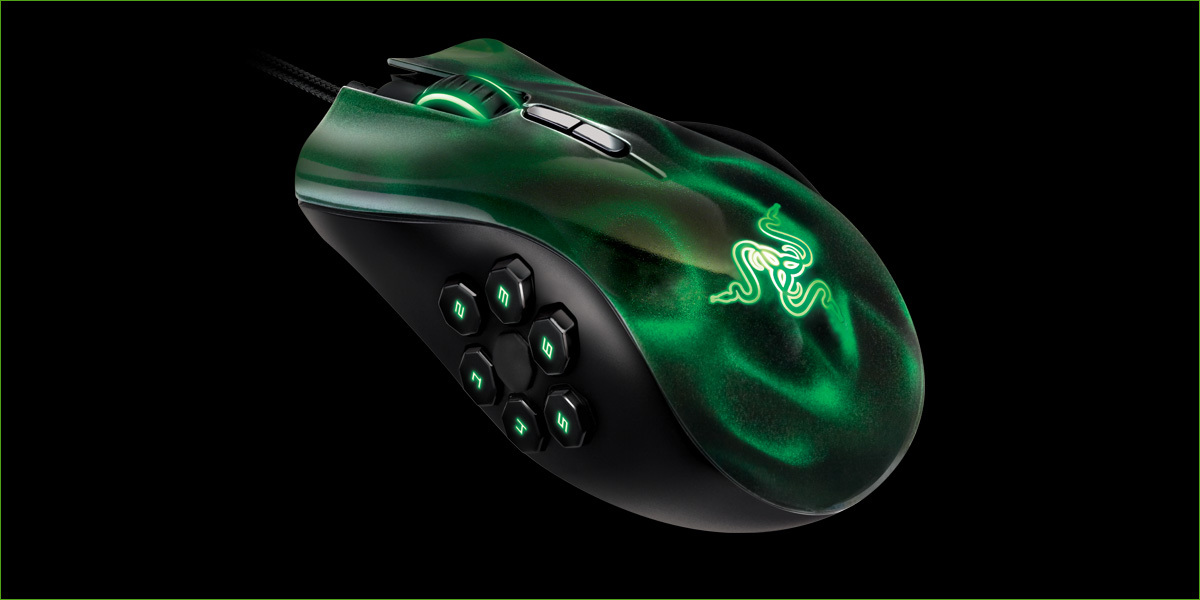
The 2014 Naga design has undergone significant changes. They literally changed everything: they removed the “pregnant” form factor, making the side keys closer and denser assembled.

Changed the slope of the side surface. We changed the wheel, adding two more degrees of freedom of scroll to it (wheel tilt ⇔ horizontal scroll). Changed the shape of the back of the mouse.
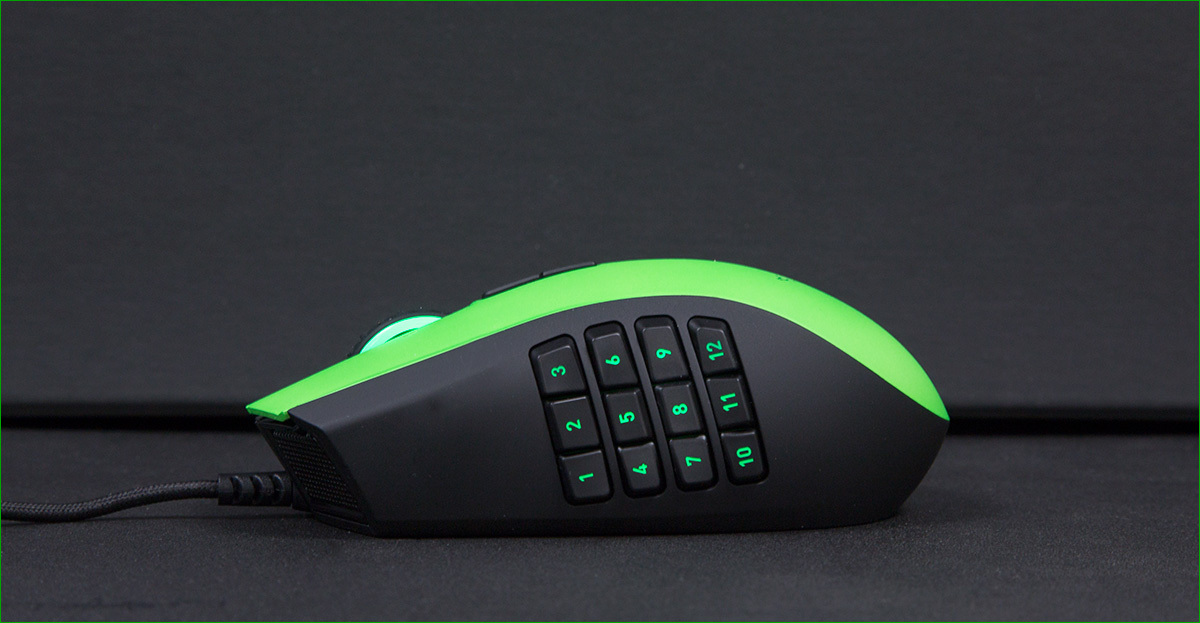
The removable side panels were removed, leaving one but comfortable surface. The concept is the same, but the implementation is many times better.

In addition, the sensations of the mouse themselves have changed: the side keys are tactilely pressed with almost perfect effort and clarity, the operation of the clicker is somewhat reminiscent of the mechanical keyboard. The body materials are still the same “dry” plastic: the mouse lies in the hand like a glove, the palm does not sweat, you do not feel fatigue even after 5-6 hours of continuous clicking on the mouse buttons. Rather, the buttons begin to smoke with something poisonous green than your hand gets tired! :)

Well, a nice bonus: Razer launches new Naga, including for lefties! So if you belong to those 7-12% of humanity that prefers to use your left hand, and have long dreamed of such a mouse, but stopped the “uncomfortable” grip - a holiday has come on your street too .
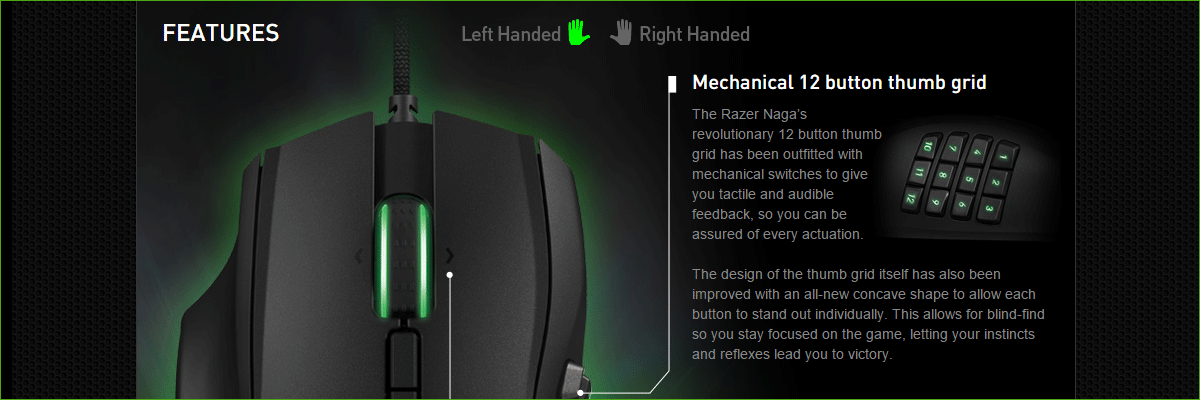
The insides of the mice have also been updated. Firstly, both mice received an updated fourth-generation sensor with a sensitivity of up to 8,200 DPI for Naga Epic 2014 and an impressive 10,000 DPI for DeathAdder.
Secondly, the controller of the mouse itself has been updated. Yes, neither the 1ms response nor the port polling frequency of 1000Hz have disappeared, but out of the box there is support for Synapse 2.0 (not all old mice have access to new software, for example, the same old mamba requires separate drivers). In general, qualitative improvements made it possible to increase the accuracy of moving the cursor to indecent: moving the cursor 1 pixel on the retina display of the laptop (3200x1800 by 13 inches) is a feat that previously seemed simply impossible. And here everything is ok. Of course, in games everything works just the same and works cool. Also, new mice acquired new parameters that can be configured in the control application.
We may write a separate huge post about the capabilities of Razer Synapse, but it is worth mentioning something in light of the multidimensionality of Razer Naga. Each of the buttons (generally each) can be reprogrammed. Moreover, Naga has not only “profiles” that can be attached to applications, but also “layouts” that can be switched inside the profile by assigning this function, for example, to the “wheel to the right”.

Macro? Easy. And not with any perversions, difficulties or incomprehensibilities. The interface is nowhere simpler. I clicked the “plus”, named the macro, in the active area I recorded the desired combination. If necessary - replaced all delays, so that the command runs faster. Done!
Assign a keyboard button instead of a mouse button? Easy peasy. Fans of MMO games with many panels with skills will definitely enjoy this feature, but my hobbies are of a slightly different nature. I almost never use all 12 buttons, but the first six are actively used in all kinds of toys and delight with an instant reaction to game events.
I would advise many people not to bother and assign a digital number of buttons for games to these buttons (from 1 to 0 and - / =, in principle, this is how the mouse was set up initially), and reassign the control itself already in games. And for the system to create a separate profile, bind it to the process explorer.exe / chrome.exe and all sorts of chips like copy-paste-forward-backward-louder-quieter snap to the buttons here, and then forget about reconfiguration for a long time.
Well, two small but useful features became a nice addition: calibrating the mouse under the surface (both branded Razer carpets and just “carpets” are supported) and setting the lift-off parameter(separation). Calibration allows you to adapt the "brains" of the mouse to the correct calculation of the distance by which you need to move the cursor and remove jerks or heterogeneities in the cursor movement. Controlled detachment allows you to interrupt the movement of the cursor depending on the settings and the height at which the mouse was raised. For some serious players, this is important and necessary: it reduces the adaptation time after the previous mouse and increases the accuracy of controlling the cursor behavior.
I’d like to say just two words about products marked with Chroma: it's high time. The backlight of the Razer products for a long time was a burning blue (and did not please the eye at all), and the backlight brightness was regulated either in the on-off range or in the states “nothing is visible - almost nothing is visible - something is warm “Spare my eyes, turn off the spotlight.” In 2013, “green” products began to appear, and in 2013-2014 the company switched almost all the lines to green backlighting: it matches the corporate logo and is generally prettier than cyanosis, which bores the eyes. There was a smooth adjustment of brightness in wide ranges.
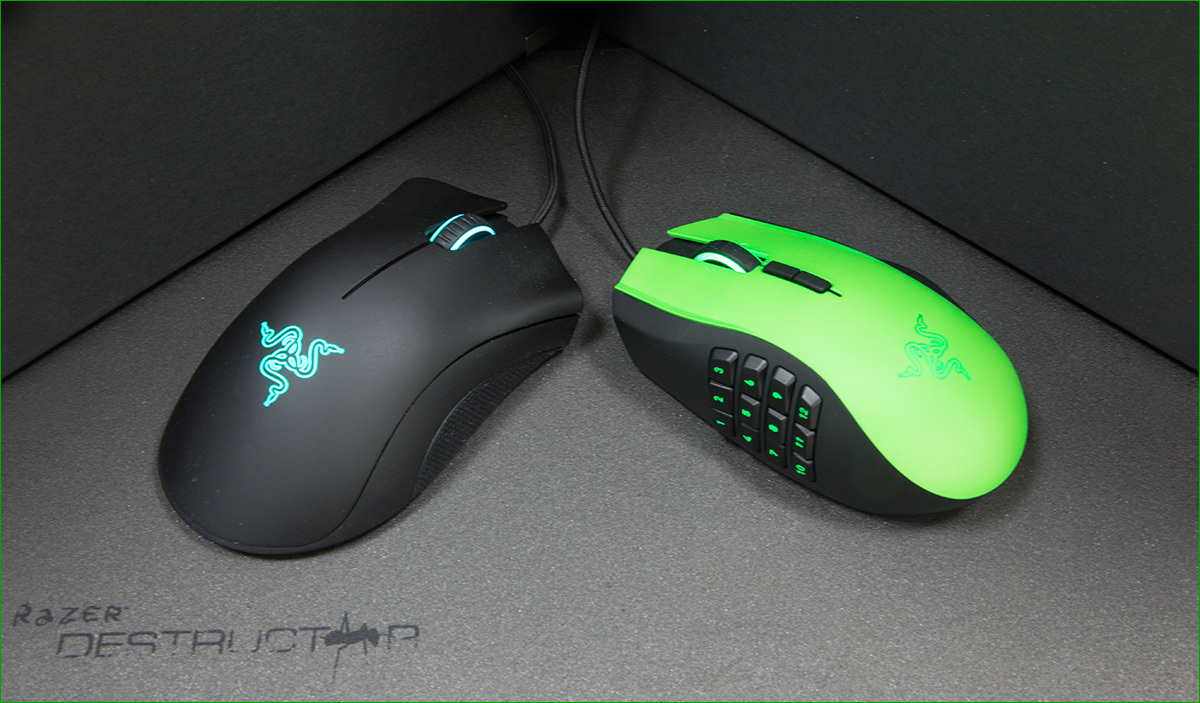
In addition, Razer launched a separate line of Chroma products with multi-color lighting, which, surprisingly, really looks very, very cool. Not only would the players have time to admire the mouse and keyboard during the game, but in the moments of rest it is really nice to watch the devices.
Firstly, the backlight is really multi-color. I came across many products in the gaming industry that claimed to be ready to provide millions of backlight colors. Usually, everything was limited to a few bright shades and some slurred porridge between them. Everything works just fine here, watch the video:
The backlight can be fixed on any specific color, it can be turned off, it can be made pulsating (it is difficult to call it soothing in this state, but some people like it). I settled on a pleasant emerald-turquoise hue (a little colder than the green highlight of the “native” color for Razer, but then personal tastes of each person decide what to look at. By the way, the same color was highlighted in one of the promo pictures for DeathAdder Chroma:

The company thoroughly worked on all its products, updating almost all product lines: keyboards, mice, headsets. Almost all of them seemed to remain the "good old Razer'om" and changed in the little things: new materials, improved ergonomics and a new filling. In all these products, you can dig for hours, comparing them with the previous generation, finding changes and improvements.
Unfortunately, in a week or a month it is difficult to say how durable the new Razer products are, whether they cured jambs of some models with reliability, how things are going with the new plastic and the new weaving of wires. I will continue to use Naga in the most hardcore mode, and at the end of the year I will summarize what happened to her, what are my impressions of Razer products that will go through my hands this year, how products are developing, what to choose and how to get the most out of Razer of the possible.
Well, if DeathAdder Chroma or Naga 2014 (by the way, in a rare green color!) Liked you today - they are on our site, order, we will test together! Good luck to you on-line battles, cool peripherals and stay connected! :)
Thank you for your attention.


Razer Naga in the 2014 version.
Author's note:
It just so happened that the Razer products in my house are not what a frequent guest would be ... Rather, a permanent resident. I had about a dozen mice, four keyboards, probably almost all, perhaps rugs, several headsets. The only product that I don’t have for personal use is the Razer laptop. At first there was no need, but now it’s just a toad strangling :) So in this review I will often refer to other products that I had experience with.
Razer as a whole is quite sensitive to fashion trends in the "game" party, does not spare money on research and development in the field of cursor positioning, keystrokes, sound transmission and much more. Yes, the company had both extremely successful products, and not very (many complained about “dying” clickers from 2012 Naga mice and Orochi falling off mounts / dying wires), but in general, my personal experience is rather on the side “ quality ”than“ overpriced consumer goods ”.
So, reviews of gaming peripherals will be conducted in the first person rather than in a corporate style: no marketer can replace personal experience and love for computer games.
In the Razer product line, mice occupy a separate category. Firstly, with the production of gaming mice Razer began their ascent to Olympus gaming peripherals. Secondly, it was high-quality mice that made the company her name and nurtured an army of fans around the world. DeathAdder is a classic ergonomic mouse for right-handed people (there is a version for left-handed people), not burdened with anything superfluous, moreover, in the Chroma version (with multi-color illumination), and the third generation of Naga mice. The third one is very formal, since the first two differed, rather, in the form of the MMO block of keys, but were technically identical.
2014 DeathAdder and General Trends
The mouse is a typical representative of Razer products throughout. My first “personal” and “favorite” mouse for Razer was a wireless Mamba, and DeathAdder at that time was a complete copy of Mamba, devoid of wireless features and associated mini-buttons. DeathAdder survived several re-releases, some of them were announced officially (hardware was replaced in the mouse), some were an easy facelift: on the Internet, I found a photo with three horsemen of the apocalypse, who would say where is which mouse, but not Google? :)

The main “upgrade” of DeathAdder was performed twice, once - inside the line of mice with a third-generation sensor, the second time - with a transfer to a 3.5G sensor. Now the mouse has been transferred to a new fourth-generation dual-sensor software and hardware platform, and even if it looks almost the same, the improvements are noticeable from the very first minutes of use.

The shape of the new DeathAdder has not changed much: the "hump" is slightly less pronounced, a drop of another bend of the working surface (buttons), in general, a thousand little things that a simple average person simply won't notice. The difference is so subtle that I would rather distinguish both mice in the nature of the cursor movement than in shape.

The key difference is other body materials. Models with a release date of 2008-2013 were characterized by a somewhat “different” design approach: some were made of high-quality semi-matte plastic, and some were made of soft-touch with glossy inserts. The gloss collected prints, and the soft-touch easily scratched with rings / jewelry / something in a backpack and began to treacherously peel off. If on desktop products this is not very noticeable and not critical, then those who wear their accessories with a laptop after a while either had to put up with a peeling coating, or disassemble the mouse and clean / paint the surface.
In 2014-2015, the company solved this problem radically. Now the main work surface and sidewalls are lost in gloss and chic in the photographs, but are made of high-quality, very “dry” and “hard” to the touch matte plastic. Tactilely very similar to carbon fiber. The material of rubber inserts has also changed, which should provide a reliable grip on the mouse: instead of soft and smooth elastic, corrugated / textured elements from harder compounds are now used. In the hand, the mouse began to lie somewhat differently - it may not look as expensive as past products, but it certainly has become better both in terms of user experience and banal practicality. Well, one of the most important improvements is the wire braid. It has become much stronger and thus more flexible (probably b used forfewer thinner threads). Let us hope that the wires cease to “double”, and the braid - fray and unwind, as was the case with some old products. Unfortunately, antifriction paws made of the same material as before were left on the mouse: on the first day they were covered with scratches and gathered a thin layer of worn material around the edges, so that with very active use, after a while they will most likely need to be replaced.
Naga 2014
I have a special relationship with Naga. I really liked the first generation of mice, but, unfortunately, it didn’t "fit" into the hand. Despite the replaceable sidewalls and the generally pleasing shape, it was "all wrong and all wrong."

Note: in this photo a rare version of the "old" Naga: molten edition.
It’s hard to say what irritated more: the “pot-bellied” design, hard-to-reach side keys or the overall shape. In general, the original Naga did not enter, although I liked the idea. A little later, Razer released a version of Naga Hex, with six (instead of twelve) function keys, but it didn’t suit me with ernomics either.

The 2014 Naga design has undergone significant changes. They literally changed everything: they removed the “pregnant” form factor, making the side keys closer and denser assembled.

Changed the slope of the side surface. We changed the wheel, adding two more degrees of freedom of scroll to it (wheel tilt ⇔ horizontal scroll). Changed the shape of the back of the mouse.

The removable side panels were removed, leaving one but comfortable surface. The concept is the same, but the implementation is many times better.

In addition, the sensations of the mouse themselves have changed: the side keys are tactilely pressed with almost perfect effort and clarity, the operation of the clicker is somewhat reminiscent of the mechanical keyboard. The body materials are still the same “dry” plastic: the mouse lies in the hand like a glove, the palm does not sweat, you do not feel fatigue even after 5-6 hours of continuous clicking on the mouse buttons. Rather, the buttons begin to smoke with something poisonous green than your hand gets tired! :)

Well, a nice bonus: Razer launches new Naga, including for lefties! So if you belong to those 7-12% of humanity that prefers to use your left hand, and have long dreamed of such a mouse, but stopped the “uncomfortable” grip - a holiday has come on your street too .

Iron
The insides of the mice have also been updated. Firstly, both mice received an updated fourth-generation sensor with a sensitivity of up to 8,200 DPI for Naga Epic 2014 and an impressive 10,000 DPI for DeathAdder.
Secondly, the controller of the mouse itself has been updated. Yes, neither the 1ms response nor the port polling frequency of 1000Hz have disappeared, but out of the box there is support for Synapse 2.0 (not all old mice have access to new software, for example, the same old mamba requires separate drivers). In general, qualitative improvements made it possible to increase the accuracy of moving the cursor to indecent: moving the cursor 1 pixel on the retina display of the laptop (3200x1800 by 13 inches) is a feat that previously seemed simply impossible. And here everything is ok. Of course, in games everything works just the same and works cool. Also, new mice acquired new parameters that can be configured in the control application.
Proprietary software
We may write a separate huge post about the capabilities of Razer Synapse, but it is worth mentioning something in light of the multidimensionality of Razer Naga. Each of the buttons (generally each) can be reprogrammed. Moreover, Naga has not only “profiles” that can be attached to applications, but also “layouts” that can be switched inside the profile by assigning this function, for example, to the “wheel to the right”.

Macro? Easy. And not with any perversions, difficulties or incomprehensibilities. The interface is nowhere simpler. I clicked the “plus”, named the macro, in the active area I recorded the desired combination. If necessary - replaced all delays, so that the command runs faster. Done!
Assign a keyboard button instead of a mouse button? Easy peasy. Fans of MMO games with many panels with skills will definitely enjoy this feature, but my hobbies are of a slightly different nature. I almost never use all 12 buttons, but the first six are actively used in all kinds of toys and delight with an instant reaction to game events.
I would advise many people not to bother and assign a digital number of buttons for games to these buttons (from 1 to 0 and - / =, in principle, this is how the mouse was set up initially), and reassign the control itself already in games. And for the system to create a separate profile, bind it to the process explorer.exe / chrome.exe and all sorts of chips like copy-paste-forward-backward-louder-quieter snap to the buttons here, and then forget about reconfiguration for a long time.
Well, two small but useful features became a nice addition: calibrating the mouse under the surface (both branded Razer carpets and just “carpets” are supported) and setting the lift-off parameter(separation). Calibration allows you to adapt the "brains" of the mouse to the correct calculation of the distance by which you need to move the cursor and remove jerks or heterogeneities in the cursor movement. Controlled detachment allows you to interrupt the movement of the cursor depending on the settings and the height at which the mouse was raised. For some serious players, this is important and necessary: it reduces the adaptation time after the previous mouse and increases the accuracy of controlling the cursor behavior.
Chroma
I’d like to say just two words about products marked with Chroma: it's high time. The backlight of the Razer products for a long time was a burning blue (and did not please the eye at all), and the backlight brightness was regulated either in the on-off range or in the states “nothing is visible - almost nothing is visible - something is warm “Spare my eyes, turn off the spotlight.” In 2013, “green” products began to appear, and in 2013-2014 the company switched almost all the lines to green backlighting: it matches the corporate logo and is generally prettier than cyanosis, which bores the eyes. There was a smooth adjustment of brightness in wide ranges.

In addition, Razer launched a separate line of Chroma products with multi-color lighting, which, surprisingly, really looks very, very cool. Not only would the players have time to admire the mouse and keyboard during the game, but in the moments of rest it is really nice to watch the devices.
Firstly, the backlight is really multi-color. I came across many products in the gaming industry that claimed to be ready to provide millions of backlight colors. Usually, everything was limited to a few bright shades and some slurred porridge between them. Everything works just fine here, watch the video:
The backlight can be fixed on any specific color, it can be turned off, it can be made pulsating (it is difficult to call it soothing in this state, but some people like it). I settled on a pleasant emerald-turquoise hue (a little colder than the green highlight of the “native” color for Razer, but then personal tastes of each person decide what to look at. By the way, the same color was highlighted in one of the promo pictures for DeathAdder Chroma:

Razer 2014
The company thoroughly worked on all its products, updating almost all product lines: keyboards, mice, headsets. Almost all of them seemed to remain the "good old Razer'om" and changed in the little things: new materials, improved ergonomics and a new filling. In all these products, you can dig for hours, comparing them with the previous generation, finding changes and improvements.
Test of time
Unfortunately, in a week or a month it is difficult to say how durable the new Razer products are, whether they cured jambs of some models with reliability, how things are going with the new plastic and the new weaving of wires. I will continue to use Naga in the most hardcore mode, and at the end of the year I will summarize what happened to her, what are my impressions of Razer products that will go through my hands this year, how products are developing, what to choose and how to get the most out of Razer of the possible.
Well, if DeathAdder Chroma or Naga 2014 (by the way, in a rare green color!) Liked you today - they are on our site, order, we will test together! Good luck to you on-line battles, cool peripherals and stay connected! :)
Thank you for your attention.


Only registered users can participate in the survey. Please come in.
What product do you want to read about next time?
- 38.1% Razer OrbWeaver: a mini-keyboard for the most necessary functions 130
- 45.7% Razer DeathStalker: gaming keyboard with a “laptop” key travel 156
- 47.8% Razer Tiamat: headphones with ten speakers and surround sound 163
